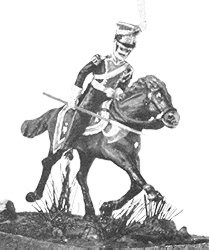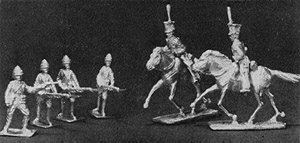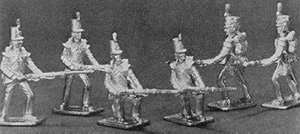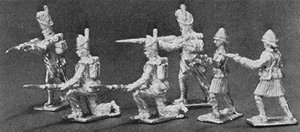| |
MILITARY MODELLING
April 1972
FIGURE REVIEW by Charles Grant
THE LES HIGGINS 25mm LINE
'Unbeatable' - a fitting tribute
to a master model maker ... |
|
| |
|
|
| |
 |
|
| |
A fine Polish Lancer of the Guard riding
at speed, an impressive figure.
|
|
| |
|
|
| |
For some considerable time the firm of Les Higgins
Miniatures has been very well known - and deservedly so -
for its series of model figures in the 20mm., 30mm., and 54mm
sizes - and frequently one would hear regrets being expressed
that there was no extension into periods other than the English
Civil War and the wars of Marlborough - I'm speaking of the
wargaming size of figure, the first mentioned, of course.
My own view was that the Marlborough figures particularly
were of an extremely high standard, mounted and foot types
as well, and to be honest, on not a few occasions 'Corporal
John's' long-coated grenadiers and musketeers found themselves
transported half a century or so through time to the later
era of the Seven Years War, wherein they fought most doughtily
and at the same time performed quite another function, that
of showing up the relatively mediocre quality of the other
troops with whom they marched. Of course, the Les Higgins
figures of the other sizes and periods - with which we are
not concerned at the moment - were equally excellent, and
in the 54mm range I have an especially high regard for the
portrait model of Charles I and for the 16th century French
arquebusier. However, as I say, it is not these with which
we are at the moment concerned, but rather with the new enterprise
undertaken by the firm - a most welcome excursion into a size
and periods both quiet new to it - the former being 25mm and
the latter not only the ever popular Napoleonic but British
Colonial as well. For some reason I cannot quite explain,
this size - the 25mm - seems to have been pretty well accepted
as a standard size for wargames, or at least as nearly standard
as one can expect to get in this: most individualistic of
hobbies.
It was to be expected, I suppose, that the new
25mm figures would follow the traditional path into the armies
of the Napoleonic Wars, but let us mention first the other
line, the types for British Colonial warfare, to be specific,
the Sudan in 1898 and the expedition of that year. This period
does not seem to be among the most popular among British wargamers,
but surprisingly enough - to me, at any rate - it has a very
considerable number of devotees in the U.S.A. (where, if I'm
not mistaken, Jack Scruby Miniatures first produced figures
for colonial warfare some years ago). And this despite what
one might imagine are American views of British colonialism
in the 'bad old days'.
At the moment, the Les Higgins colonial figures
are less numerous than their Napoleonic fellows, and, naturally
enough, consist of British troops - horse and foot - and 'Fuzzy
Wuzzies' and Dervishes, likewise foot and mounted. The British
representatives are line infantry and Highland infantry -
both with the typical pith helmet - in what are the firm's
standard four attitudes - 'at the ready', 'advancing', standing
firing' and 'kneeling firing'. The last two are not of great
interest to me personally - it is a simple idiosyncrasy that
I don't like figures in violent postures or firing attitudes,
but there, that's just me. Officers, again, all seem to be
left handed, or at least they are firing pistols with this
hand. But these are quite definitely all my 'gripes' - the
finish, moulding and general overall appearance of the figures
are quite beyond criticism. Quite simply, I have seen nothing
better the detail would do credit to very much larger figures
and that's a fact. The British cavalryman - a lancer, naturally,
with Omdurman in mind - is an admirable action piece. He comes
without lance, but one made from piano or florist's wire can
easily be fixed in place - no trouble there. The Fuzzy-Wuzzies
- running or advancing - with spear and shield, are most aggressive
looking characters (and, dare I whisper it, could well figure
in certain 'ancient' armies, say the Carthaginian!), while
the Dervish' horseman, with huge leaf-bladed sword, looks
most impressive.
|
|
| |
|
|
| |
 |
|
| |
British Colonial Line infantry - an officer
and privates - and two French Napoleonic Lancers of the Guard,
probably among the most spectacular and colourful of all Napoleon's
Cavalrymen.
|
|
| |
|
|
| |
But now for the much more extensive line - the
British and 'French troops of the Napoleonic period. At the
moment these consist of British line and light infantry, as
well as riflemen, French Imperial Guard infantry - the Old,
Middle, and Young Guard all being represented - and, rather
surprisingly, 'dragons a pied', the foot dragoons. The French
are in three positions, the British in four, the additional
one for the latter being the 'kneeling ready'. This is one
on which I just have to comment, although it does not really
come within my own quite arbitrary category of 'fightable'
positions. It must be mentioned, though, because of its sheer
excellence. It is quite remarkable how, when examining the
figure - all 25mm of it - what a distinct impression one gets
- paradoxically enough - of the action and vigour of this
more or less static pose. One can see clearly just how the
man is braced in position, tense and ready, musket butt firmly
against right hip, awaiting a whirlwind of enemy cavalry.
It is difficult to over praise the designer, it is really
a tiny work of art. The uniform details are faultless, as
is the case with all the figures.
|
|
| |
|
|
| |
 |
|
| |
British Light Infantry in two positions and
their opposition, two men from French 'flank' companies of
a Line Regiment.
|
|
| |
|
|
| |
Among the French, the Guard types are very good,
details of equipment, pack, etc., being most clearly defined.
With the men of the line, the flank companies - grenadier
and voltigeur - have the correct 'sabre-briquet' and the bayonet
scabbard on the same cross-belt, that coming from the right
shoulder, while those of the battalion companies, with no
right shoulder belt, have bayonet scabbard on the left shoulder
belt just in front of the 'giberne' or ammunition pouch. Line
infantry are in trousers, light in the characteristic short
gaiters, and in both cases the uniform coat is of the closed
front 1812 pattern. I have wondered about the inclusion of
the dismounted dragoons. They are every bit as good as the
infantry - the figure is, I mean - but historically they did
not perform many outstanding feats - usually it was not a
success to give one soldier the dual role of infantryman and
cavalryman. Be that as it may, though, painted in the dark
dragoon green, with brass ornamented helmet, they are really
very striking. One very small criticism I have, and this refers
to attitude and not figure quality, concerns the officers
of the infantry units. Every one is in the same position -
standing, left foot placed upon a small sort of hillock, left
arm raised with hand in a pointing position. I personally
would have preferred to see something a little more bellicose
nothing really wild, of course say, standing with drawn sword.
This is a very small complaint, though, and serves but to
show how pushed I am to find something even mildly critical
to say.
Finally the cavalry, a British hussar and a
French lancer of the Guard, the latter being equally suitable,
I should say, for painting as either Polish Lancer or Red
Lancer. The lance has to be added with florist's wire, and
as can be seen, the finished article is really attractive.
|
|
| |
|
|
| |
 |
|
| |
A mixed lot - French Old Guard firing, British
Infantry 'kneeling ready' and two Highland officers from the
British Colonial line. Note detail on the rear of the Old
Guard Grenadier.
|
|
| |
|
|
| |
There is absolutely no doubt whatsoever that
Napoleonic wargamers are amongst the most spoiled in the hobby,
and with these new Les Higgins figures their combined cup
must be pretty well overflowing. At about 29p per pack - 4
foot or two cavalry figures - they are unbeatable by any standards.
|
|
| |
|
|
|